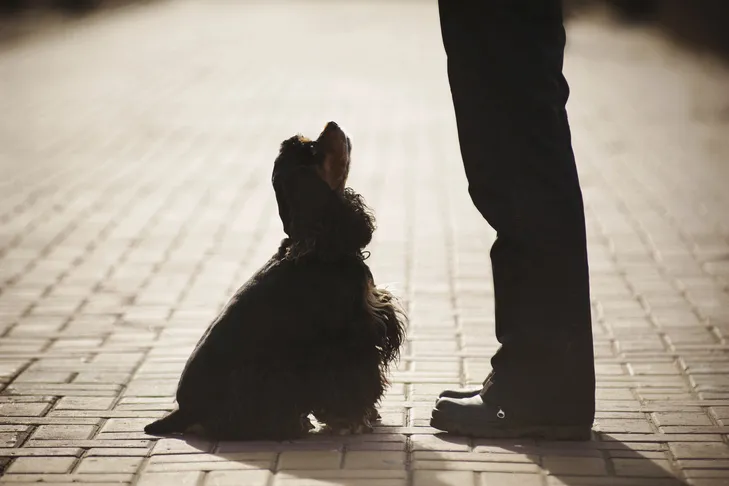Teaching your dog to sit is one of the most fundamental obedience commands, crucial for establishing good behavior and strengthening your bond. While it might seem simple, many dog owners find themselves struggling to achieve a consistent, reliable sit. Dogs may pop back up immediately or even refuse to sit at all. If you’re facing these challenges or simply want to ensure your dog masters this essential command, this guide will provide clear, actionable steps and valuable tips for success. Mastering the “sit” command is the cornerstone of more advanced training and can help manage a variety of canine behaviors, preventing issues like how to stop dogs jumping on couch.
Mastering the Basic Sit: Step-by-Step Training
The most effective and widely used method for teaching your dog to sit is through lure and reward training, often combined with a clicker to precisely mark the desired behavior. Using high-value treats that your dog finds particularly enticing is key to motivation. It’s best to conduct training sessions in a calm environment with minimal distractions, ensuring your dog is relaxed and receptive to learning.
Here’s how to lure your dog into a sit:
- Preparation: Stand or kneel in front of your dog. Have a tasty treat readily available in one hand.
- The Lure: Hold the treat close to your dog’s nose.
- The Movement: Slowly move the treat upwards and slightly back over your dog’s head, towards their tail. As your dog follows the treat with their nose, their head will naturally tilt up, and their rear end should lower towards the ground.
- Mark and Reward: The instant your dog’s rear touches the ground, use your clicker to mark the behavior. Immediately follow with verbal praise and offer the treat. This positive reinforcement solidifies the connection between the action, the reward, and the command.
- Reset and Repeat: To encourage your dog to stand again, you can either walk a short distance away and call them, or toss a treat a few feet in front of them. Once they stand, repeat steps 1-4.
- Fading the Lure: Once your dog reliably follows the treat into a sit, it’s time to transition away from the physical lure. Begin using an empty hand to mimic the luring motion. Still reward with a treat from your other hand. This empty hand movement will gradually become your visual cue for “sit.”
- Adding the Verbal Cue: When your dog consistently sits in response to your empty hand signal, start introducing the verbal command. Say “sit” just before you give the hand signal. With consistent practice, your dog will eventually respond to the verbal cue alone, even without the hand signal. This foundational skill is crucial for developing a well-behaved companion and can be a stepping stone to addressing other obedience challenges, such as how to get your dog to stop pulling the leash.
 A Beagle sitting patiently in its open crate, showcasing a calm demeanor after a successful training session.
A Beagle sitting patiently in its open crate, showcasing a calm demeanor after a successful training session.
Essential Tips for Successful Sit Training
To ensure a positive and effective training experience, keep these tips in mind:
- Avoid Physical Force: Never push down on your dog’s hindquarters to force them into a sit. This can be intimidating, confusing, and may even lead to fear or resistance towards training.
- Timing is Crucial: Ensure you are rewarding the dog while they are in the sitting position. If you delay the reward or accidentally lure them back into a standing position while reaching for a treat, you might inadvertently teach them to pop up quickly after sitting.
- Luring from a Down Position: If your dog is having significant difficulty, you can adapt the lure method starting from a down position. Hold a treat at their nose and slowly lift it upwards. Reward any movement that brings their chest up. Gradually increase the height of the lure in subsequent repetitions, guiding them into a sit. This gradual shaping helps dogs that might be hesitant.
- Capturing the Behavior: Sometimes, dogs offer behaviors spontaneously. If your dog sits on their own, immediately click (if using a clicker), praise, and reward them. This is called “capturing” the behavior. After several instances, you can start to pair the verbal cue “sit” just before you anticipate they will sit on their own.
If your dog struggles with indoor potty training, understanding basic commands can be a great start. You might find our guide on how to get your dog to pee in the garden helpful.
 A Cocker Spaniel is pictured sitting attentively in front of a person, demonstrating responsiveness to a command.
A Cocker Spaniel is pictured sitting attentively in front of a person, demonstrating responsiveness to a command.
Cultivating “Default” Sits: Making it Their Choice
The ultimate goal is for your dog to choose to sit in various situations without needing a direct command. These are known as “default behaviors.” The more you practice and reinforce the sit command, the more likely your dog is to offer it.
To truly encourage this, reward your dog for sitting spontaneously. If your dog sits when you approach them, or sits while waiting for their food, acknowledge and reward this initiative with praise and a treat. Initially, you might still need to give the verbal cue, but with consistency, they will begin to offer sits proactively. This makes your dog’s “please” and fosters a more cooperative relationship. For longer absences, understanding appropriate crate durations is also key, as covered in how long can my dog stay in the crate.
Teaching the “Sit Pretty” Trick
Once your dog has a solid understanding of the basic sit, you can move on to teaching a fun and impressive trick: “sit pretty.” This involves your dog sitting on their haunches with their front paws lifted in a begging posture.
Here’s how to teach it:
- Start with a Sit: Ask your dog to sit.
- The Lure for Elevation: Hold a treat near your dog’s nose and slowly lift it upwards and slightly back. Your dog will likely rise to follow the treat.
- Mark and Reward the Rise: The moment your dog lifts their front paws off the ground, click (if applicable), praise, and reward.
- Increase the Height: Gradually increase the height you lift the treat with each repetition. Continue this until your dog is holding the “sit pretty” position for a brief moment before receiving the reward.
- Fade the Lure: As with the basic sit, transition to using an empty hand for the lure. This hand motion will become your hand signal for “sit pretty.” Continue to reward the behavior.
- Add the Verbal Cue: Once your dog reliably performs the trick with the hand signal, introduce a verbal cue, such as “sit pretty” or “beg,” just before you give the hand signal. Over time, your dog should respond to the verbal cue alone.
If your dog struggles with balance, you can offer your forearm as a temporary support for their front paws as they learn to balance themselves. This trick is a delightful addition to your dog’s repertoire and demonstrates advanced training capabilities, which can also help curb unwanted behaviors like how to stop a dog from jumping on me.
 A Pembroke Welsh Corgi is seen sitting up on its hind legs in a begging pose outdoors, demonstrating a learned trick.
A Pembroke Welsh Corgi is seen sitting up on its hind legs in a begging pose outdoors, demonstrating a learned trick.
By following these steps and employing positive reinforcement techniques, you can successfully teach your dog to sit, transforming them into a well-behaved and responsive companion.
References
- American Kennel Club (AKC). (n.d.). How to Teach Your Dog to Sit Pretty. Retrieved from AKC Website
- American Kennel Club (AKC). (n.d.). Lure-Reward Training for Dogs. Retrieved from AKC Website
- American Kennel Club (AKC). (n.d.). Understanding Your Dog Can Make You a Better Trainer. Retrieved from AKC Website
- American Kennel Club (AKC). (n.d.). Using Verbal Commands Effectively. Retrieved from AKC Website
- American Kennel Club (AKC). (n.d.). What is Shaping in Dog Training? Retrieved from AKC Website
